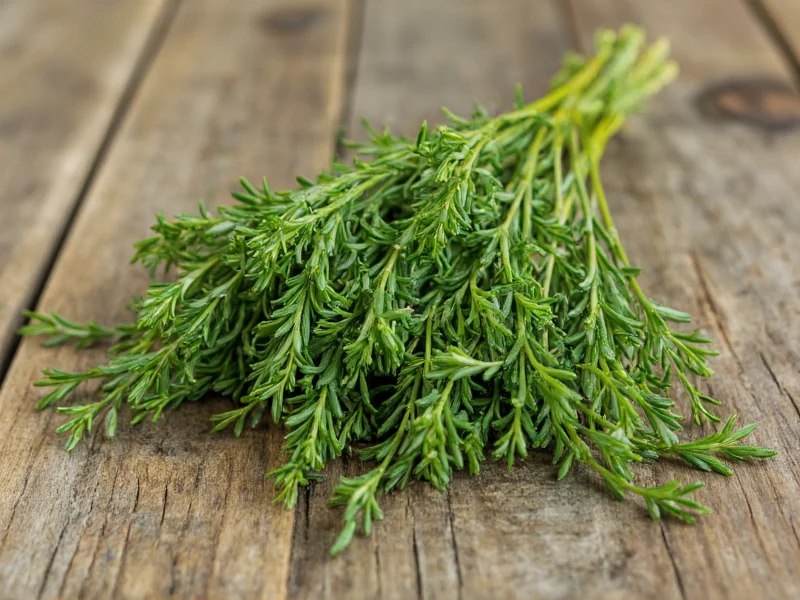Understanding Thyme: More Than Just a Kitchen Staple
Thyme has been cherished for thousands of years, with historical records showing its use by ancient Egyptians for embalming and by Greeks as temple incense. The herb's name derives from the Greek word thymos, meaning spirit or courage, reflecting its historical association with vitality. Today, thyme remains indispensable in kitchens worldwide, particularly in French, Mediterranean, and Middle Eastern cuisines.
Popular Varieties of Thyme for Culinary and Garden Use
While common thyme (Thymus vulgaris) dominates culinary applications, numerous varieties offer unique flavors and growing characteristics. Understanding these differences helps home cooks and gardeners select the best type for their needs.
| Variety | Flavor Profile | Best Uses | Growing Conditions |
|---|---|---|---|
| Common Thyme | Earthy, slightly minty | Roasts, stews, braises | Full sun, well-drained soil |
| Lemon Thyme | Citrus-forward, bright | Fish, poultry, desserts | Partial shade, moist soil |
| French Thyme | Strong, robust | Classic French cuisine | Full sun, dry conditions |
| Creeping Thyme | Mild, ornamental | Garnish, ground cover | Full sun, rock gardens |
Culinary Applications: Maximizing Thyme's Flavor Potential
Professional chefs understand that fresh thyme versus dried thyme creates dramatically different results in cooking. Fresh thyme works best added late in the cooking process to preserve volatile oils, while dried thyme benefits from earlier addition to rehydrate and release flavors. When substituting dried for fresh, use one-third the amount since drying concentrates the herb's essential oils.
Thyme complements specific food pairings exceptionally well. For meat dishes, combine thyme with rosemary and garlic for robust flavors. In vegetable preparations, thyme enhances tomatoes, mushrooms, and root vegetables. The herb's natural affinity for lemon creates bright flavor combinations perfect for seafood and poultry dishes. Understanding these culinary synergies elevates everyday cooking into restaurant-quality meals.
Growing Thyme Successfully at Home
Growing thyme in containers offers gardeners flexibility and control over soil conditions. Select pots with excellent drainage and use a sandy potting mix to prevent root rot. Place containers in locations receiving at least six hours of direct sunlight daily. Water thyme only when the top inch of soil feels dry, as overwatering remains the most common cause of failure when cultivating this Mediterranean native.
For garden beds, amend heavy soils with perlite or coarse sand to improve drainage. Space plants 12-18 inches apart to ensure proper air circulation, which prevents fungal diseases. In colder climates, apply mulch after the first frost to protect perennial thyme plants through winter. Regular harvesting actually encourages bushier growth, making thyme both practical and rewarding for home gardeners.
Scientifically Supported Health Benefits of Thyme
Research confirms thyme contains thymol, a compound with demonstrated antimicrobial properties. Studies published in the Journal of Agricultural and Food Chemistry show thyme extract effectively inhibits foodborne pathogens like E. coli and Salmonella. The herb's high antioxidant content, particularly rosmarinic acid, contributes to its anti-inflammatory effects observed in laboratory studies.
Traditional medicinal uses of thyme for respiratory conditions find support in modern research. A clinical trial in Phytotherapy Research demonstrated that a thyme extract syrup significantly reduced cough frequency in patients with acute bronchitis. While culinary amounts won't replace medical treatment, incorporating thyme into regular cooking contributes to a health-supportive diet.
Preserving Thyme for Year-Round Use
Freezing fresh thyme preserves more flavor than drying. Simply strip leaves from stems, spread them in a single layer on a baking sheet, and freeze before transferring to airtight containers. Frozen thyme works perfectly in cooked dishes without thawing. For drying thyme, hang small bundles upside down in a dark, well-ventilated space for 1-2 weeks until leaves crumble easily.
Creating thyme-infused oils provides another preservation method with culinary versatility. Combine fresh thyme sprigs with high-quality olive oil in a clean jar, ensuring the herb remains submerged. Store in the refrigerator for up to two weeks for immediate use, or properly process for shelf-stable storage using tested canning methods. Never store herb-infused oils at room temperature due to botulism risk.
Common Substitutions When Thyme Isn't Available
When thyme isn't available, oregano makes the closest substitute due to similar flavor compounds, though it delivers a more pungent taste. Marjoram offers a milder alternative with comparable floral notes. For recipes featuring lemon thyme, combine regular thyme with lemon zest to approximate the flavor profile. Understanding these substitutions prevents recipe failures when your preferred herb runs out.











 浙公网安备
33010002000092号
浙公网安备
33010002000092号 浙B2-20120091-4
浙B2-20120091-4